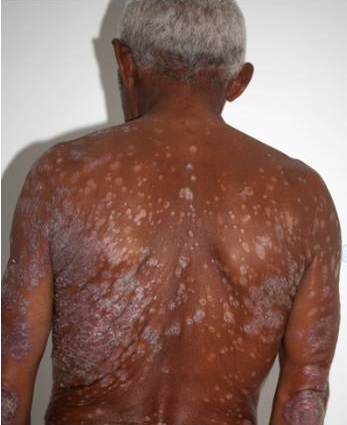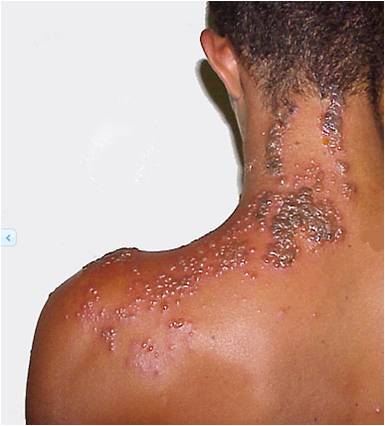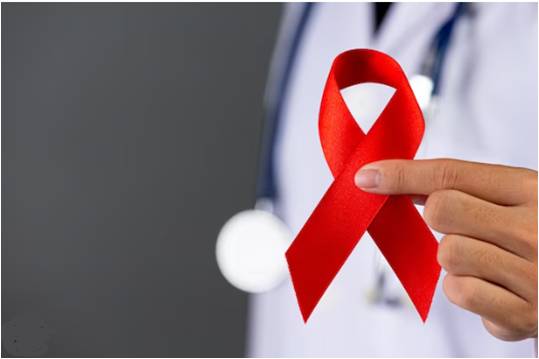10 Common HIV Skin Conditions in Africans and Their Treatment
By: Foluke Akinwalere. Freelance Health Writer. With medical review and editorial support by the DLHA Team

Black man with HIV skin condition on the back.
There are 25.6 million people living with HIV in the African region [1], making HIV/AIDS a significant health concern.
Among the various complications of HIV, skin lesions are common and can often serve as important indicators of an underlying infection. Skin conditions have played a critical role in understanding disease progression, immune status, and therapeutic responses.
From benign rashes to severe opportunistic infections, the skin reflects the intricate interplay between the virus, host immune responses, and environmental factors.
This presentation will attempt to give you a comprehensive illustrated guide for recognising HIV-related skin diseases in Africans.
Skin lesions or conditions are common in people with HIV/AIDS. The different types fall into these four categories:
Examples of HIV-specific skin disorders include:
Examples of HIV opportunistic skin disorders include:
Examples of HIV-associated skin malignancies include:
Examples of common antiretroviral drugs causing skin eruptions include:
These include:
1. Kaposi’s Sarcoma
2. Herpes Virus Infections
3. Mollumscum Contagiosum
4. Pruritic Papular Eruption (PPE)
5. Eosinophilic Folliculitis
6. Erythema Multiforme (Stevens-Johnson Syndrome)
7. Candidiasis (Thrush)
8. Scabies
9. Psoriasis
10. Seborrhoeic Dermatitis
Kaposi’s sarcoma of the left sole of foot. Click on image to enlarge. Credit
Kaposi’s Sarcoma (KS) is a type of cancer that often affects people with weakened immune systems such as HIV or AIDS. It causes lesions to grow in the skin, lymph nodes, internal organs, and mucous membranes. The lesions are flat patches or nodules that appear red or purplish red on light skin and bluish, brownish, or black on dark skin. The common locations for the lesions are the feet, legs, and face. They are painless and not itchy. Its appearance on the skin was a highly stigmatising sign of HIV infection during the height of the AIDS epidemic. [2]
The American Cancer Society states that antiretroviral therapy (ART) may be the sole treatment necessary to manage Kaposi sarcoma. Local therapy, such as surgery, freezing with liquid nitrogen, or topical retinoid treatment, may also be used to treat individual skin lesions.

Left sides herpes zoster infection of back of neck, shoulder and back. Credit.
Several types of herpes infections are common in people with HIV/AIDS.
Herpes zoster (shingle), one of the HIV indicator conditions, is caused by the same virus (varicella-zoster virus) that causes chickenpox. It is an extremely painful blistering rash, usually on one side of the body. In Africa, when a patient presents with herpes zoster, doctors do consider the possibility of HIV infection, as herpes zoster has frequently been the initial sign of HIV infection since the start of the AIDS epidemic. [3]
Herpes simplex virus (HSV) is also a common infection that can cause painful blisters or ulcers. It is primarily spread by skin-to-skin contact. It is treatable but not curable. [4] The infection can more be serious in HIV patients and can come back more often.
The treatment for herpes is typically the same for individuals with or without HIV. It commonly involves the use of acyclovir or similar acyclovir-related medications.
Molluscum Contagiosum. Click on image to enlarge Credit
Molluscum contagiosum (MC) is a common, harmless viral skin infection caused by the virus of the same name. In individuals with fully functional immune systems, the disease typically resolves on its own, but it can be more severe and long-lasting in those with HIV infection. [5] It is contagious and marked by smooth white or flesh-coloured bumps on the skin.
The American Academy of Dermatology recommends antiretroviral therapy as the primary treatment for individuals with HIV and molluscum contagiosum. Additional treatment options may involve topical medications, cryotherapy, or laser therapy. The number of required treatments may vary depending on the extent of the condition.
.jpg)
Image: Pruritic Papular Eruption (PPE).
The pruritic papular eruption is a chronic skin condition characterised by the presence of itchy papules of unknown origin, symmetrically distributed on the trunk, limbs, and sometimes face. This condition is frequently seen in individuals with HIV and can significantly impact their health. PPE may serve as an early indicator of HIV infection. It presents as small, light to dark brown red, intensely firm papules, evolving into hyperpigmented macules and nodules.
The treatment for Pruritic Papular Eruption typically involves topical orticosteroids and antihistamines to alleviate itching and inflammation.
Eosinophilic Folliculitis. Click on image to enlarge. Credit
Eosinophilic folliculitis is a skin condition characterised by itchy follicular papules or pustules, mainly found on the scalp, face, neck, and upper chest. It is frequently seen in individuals with advanced HIV infection. It is believed to be a reaction to certain antigens in the pilosebaceous glands, possibly triggered by autoimmunity, Pityrosporum yeast, and certain bacteria. [6]
Various treatments, such as oral and topical medications like steroids or antibiotics, can be effective. Antiretroviral therapy is known to significantly reduce or even eliminate symptoms
Erythema Multiforme (Stevens–Johnson Syndrome). Click on image to enlarge. Credit.
Stevens-Johnson syndrome (SJS) is a serious and potentially fatal type of erythema multiforme that is commonly linked to a hypersensitivity reaction to medication. Individuals with HIV are at an increased risk of developing this complication. It is an acute, occasionally recurring condition affecting the skin and mucous membranes, presenting as papular, bullous, and necrotic lesions that are caused by specific antigen triggers. Patients with HIV, receiving corticosteroids, immunosuppressed, having undergone a bone marrow transplant, and with lupus are at increased risk of developing erythema multiforme. [7]
The treatment for erythema multiforme typically involves symptomatic relief with corticosteroids, antihistamines, and topical treatments, while addressing any underlying causes or triggers.
But when the symptom upgraded to Stevens-Johnson Syndrome the treatment often required immediate hospitalisation and supportive care, including discontinuation of the offending medication, fluid replacement, pain management, and sometimes immunosuppressive therapy under close medical supervision.
Image: Candidiasis (Thrush) of the tongue. Click on image to enlarge. Credit
Candidiasis (thrush) is a fungal infection caused by a type of yeast called Candida. People living with HIV infection are more prone to candidiasis. It is characterised by thick, white patches on the tongue, as well as, other parts of the mouth and throat. When candidiasis occurs in the vagina, it is identified by a thick, cottage cheese-like discharge from the vagina. Symptoms such as vaginal burning, itching, and soreness are frequently experienced during episodes. Less frequently observed, candida infections may also manifest on the skin, under the fingernails or toenails, in the rectum, anus, or penis.
Depending on the parts of the body affected, Tthe treatment for candidiasis typically involves the use of systemic or topical antifungal medications or both, such as fluconazole or topical clotrimazole, to eliminate the yeast infection.
Crusted Scabies on the thighs. Click on image to enlarge, Credit.
Individuals with weakened immune systems, such as those with HIV, are at risk of developing crusted (Norwegian) scabies. [8] This advanced form of the infection can involve a large number of mites and results in dry, scaly patches on the skin. Crusted scabies are highly contagious and can lead to secondary infections, posing a serious threat to life. Itching may not be a prominent feature in cases of crusted scabies.
The treatment for scabies often involves the application of topical medications such as permethrin or oral medications like ivermectin to eliminate the mites causing the infestation.
Image: Psoriasis of the lower back. Click on image to enlarge. Credit.
Psoriasis is a common skin condition in individuals with HIV. It is characterised by thickened skin with light to dark brown, purple or gray skin discolouration. Sometimes, skin discoloration isn’t visible on dark skin tones. It can be more severe in HIV patients, with a higher likelihood of nail involvement and itching. Arthritis may also accompany psoriasis in HIV patients. One notable difference in HIV-associated psoriasis is the increased chance of having multiple types of psoriasis at the same time in one patient [6]. The immune dysregulation caused by HIV may contribute to the development of psoriasis in these individuals.
Treatment
The treatment for psoriasis often includes topical corticosteroids, vitamin D analogs, and moisturisers to manage symptoms, while systemic medications or phototherapy may be recommended for more severe cases.
Image: Seborrhoeic Dermatitis. Credit.
Seborrhoeic dermatitis is common in individuals with an HIV infection. It can occur during any stage of an HIV infection. It is a chronic skin condition characterised in black skin by brownish, red, itchy, and flaky patches, particularly in areas rich in oil glands such as the scalp, face, and upper chest.
Treatment
Seborrheic dermatitis often gets better with the use of effective antiretroviral therapy. Common treatments involve antifungal medications like topical ketoconazole. Antifungal shampoos are effective in managing seborrheic dermatitis on the scalp.

HIVAIDS Red ribbon sign
HIV-related skin conditions pose significant challenges for individuals living with HIV/AIDS in Africa. Early recognition and diagnosis are crucial for timely intervention and improved outcomes. Also continued education, awareness efforts, improved funding and research are essential for the effective management of HIV-associated skin conditions in Africans.
1. World Health Organization. HIV/AIDS [Internet. n.d.] Accessed March 20, 2024. Available from https://www.afro.who.int/health-topics/hivaids
2. Cesarman E, Damania B, Krown SE, Martin J, Bower M, Whitby D. Kaposi Sarcoma. Nat Rev Dis Primers. 2019 Jan 31;5(1):9. doi: 10.1038/s41572-019-0060-9. Available from: https://www.ncbi.nlm.nih.gov/pmc/articles/PMC6685213/.
3. Leppard B, Naburi AE. Herpes zoster: an early manifestation of HIV infection. Afr Health. 1998 Nov;21(1):5-6. Available from: https://pubmed.ncbi.nlm.nih.gov/12294921/.
4. World Health Organization. Herpes Simplex Virus. [Internet. 5 April 2023.] Accessed March 21, 2024. Available from https://www.who.int/news-room/fact-sheets/detail/herpes-simplex-virus.
5. Vora RV, Pilani AP, Kota RK. Extensive Giant Molluscum Contagious in a HIV Positive Patient. J Clin Diagn Res. 2015 Nov;9(11):WD01-2. doi: 10.7860/JCDR/2015/15107.6797. Available from: https://www.ncbi.nlm.nih.gov/pmc/articles/PMC4668510/.
6. Mohseni Afshar Z, Goodarzi A, Emadi SN, Miladi R, Shakoei S, Janbakhsh A, Aryanian Z, Hatami P. A Comprehensive Review on HIV-Associated Dermatologic Manifestations: From Epidemiology to Clinical Management. Int J Microbiol. 2023 Jul 18;2023:6203193. doi: 10.1155/2023/6203193. Available from: https://www.ncbi.nlm.nih.gov/pmc/articles/PMC10368516.
7. Hafsi W, Badri T. Erythema Multiforme. [Updated 2023 May 27]. In: StatPearls [Internet]. Treasure Island (FL): StatPearls Publishing; 2024 Jan-. Available from: https://www.ncbi.nlm.nih.gov/books/NBK470259/.
8. World Health Organization. Scabies. [Internet , 31 May 2023} Accessed March 22, 2024. Available from: https://www.who.int/news-room/fact-sheets/detail/scabies#:~:text=People%20with%20suppressed%20immune%20systems,often%20does%20not%20cause%20itch.
More resources on skin disorders in Africans:
5 Common Skin Diseases In Africa
Eczema In African Adults: Causes, Types, and Symptoms
Eczema in African Adults: Diagnosis and Treatment
Published: April 5 2024
© 2024. Datelinehealth Africa Inc. All rights reserved.
Permission is given to copy, use and share content freely for non-commercial purposes without alteration or modification and subject to attribution as to source.
DATELINEHEALTH AFRICA INC., is a digital publisher for informational and educational purposes and does not offer personal medical care and advice. If you have a medical problem needing routine or emergency attention, call your doctor or local emergency services immediately, or visit the nearest emergency room or the nearest hospital. You should consult your professional healthcare provider before starting any nutrition, diet, exercise, fitness, medical or wellness program mentioned or referenced in the DatelinehealthAfrica website. Click here for more disclaimer notice.